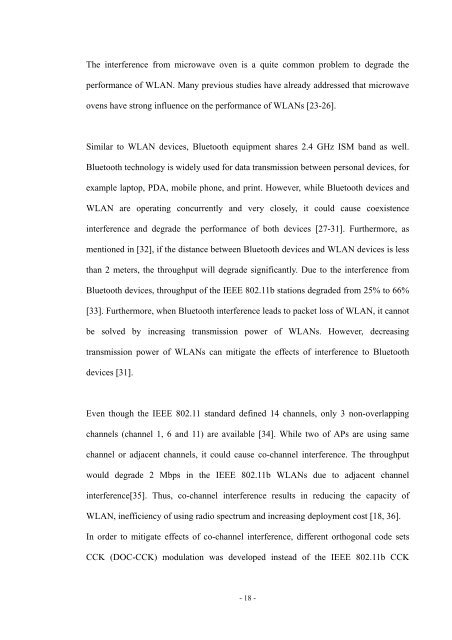An Investigation of the Impact of Signal Strength on Wi-Fi Link ...
An Investigation of the Impact of Signal Strength on Wi-Fi Link ...
An Investigation of the Impact of Signal Strength on Wi-Fi Link ...
You also want an ePaper? Increase the reach of your titles
YUMPU automatically turns print PDFs into web optimized ePapers that Google loves.
The interference from microwave oven is a quite comm<strong>on</strong> problem to degrade <str<strong>on</strong>g>the</str<strong>on</strong>g><br />
performance <str<strong>on</strong>g>of</str<strong>on</strong>g> WLAN. Many previous studies have already addressed that microwave<br />
ovens have str<strong>on</strong>g influence <strong>on</strong> <str<strong>on</strong>g>the</str<strong>on</strong>g> performance <str<strong>on</strong>g>of</str<strong>on</strong>g> WLANs [23-26].<br />
Similar to WLAN devices, Bluetooth equipment shares 2.4 GHz ISM band as well.<br />
Bluetooth technology is widely used for data transmissi<strong>on</strong> between pers<strong>on</strong>al devices, for<br />
example laptop, PDA, mobile ph<strong>on</strong>e, and print. However, while Bluetooth devices and<br />
WLAN are operating c<strong>on</strong>currently and very closely, it could cause coexistence<br />
interference and degrade <str<strong>on</strong>g>the</str<strong>on</strong>g> performance <str<strong>on</strong>g>of</str<strong>on</strong>g> both devices [27-31]. Fur<str<strong>on</strong>g>the</str<strong>on</strong>g>rmore, as<br />
menti<strong>on</strong>ed in [32], if <str<strong>on</strong>g>the</str<strong>on</strong>g> distance between Bluetooth devices and WLAN devices is less<br />
than 2 meters, <str<strong>on</strong>g>the</str<strong>on</strong>g> throughput will degrade significantly. Due to <str<strong>on</strong>g>the</str<strong>on</strong>g> interference from<br />
Bluetooth devices, throughput <str<strong>on</strong>g>of</str<strong>on</strong>g> <str<strong>on</strong>g>the</str<strong>on</strong>g> IEEE 802.11b stati<strong>on</strong>s degraded from 25% to 66%<br />
[33]. Fur<str<strong>on</strong>g>the</str<strong>on</strong>g>rmore, when Bluetooth interference leads to packet loss <str<strong>on</strong>g>of</str<strong>on</strong>g> WLAN, it cannot<br />
be solved by increasing transmissi<strong>on</strong> power <str<strong>on</strong>g>of</str<strong>on</strong>g> WLANs. However, decreasing<br />
transmissi<strong>on</strong> power <str<strong>on</strong>g>of</str<strong>on</strong>g> WLANs can mitigate <str<strong>on</strong>g>the</str<strong>on</strong>g> effects <str<strong>on</strong>g>of</str<strong>on</strong>g> interference to Bluetooth<br />
devices [31].<br />
Even though <str<strong>on</strong>g>the</str<strong>on</strong>g> IEEE 802.11 standard defined 14 channels, <strong>on</strong>ly 3 n<strong>on</strong>-overlapping<br />
channels (channel 1, 6 and 11) are available [34]. While two <str<strong>on</strong>g>of</str<strong>on</strong>g> APs are using same<br />
channel or adjacent channels, it could cause co-channel interference. The throughput<br />
would degrade 2 Mbps in <str<strong>on</strong>g>the</str<strong>on</strong>g> IEEE 802.11b WLANs due to adjacent channel<br />
interference[35]. Thus, co-channel interference results in reducing <str<strong>on</strong>g>the</str<strong>on</strong>g> capacity <str<strong>on</strong>g>of</str<strong>on</strong>g><br />
WLAN, inefficiency <str<strong>on</strong>g>of</str<strong>on</strong>g> using radio spectrum and increasing deployment cost [18, 36].<br />
In order to mitigate effects <str<strong>on</strong>g>of</str<strong>on</strong>g> co-channel interference, different orthog<strong>on</strong>al code sets<br />
CCK (DOC-CCK) modulati<strong>on</strong> was developed instead <str<strong>on</strong>g>of</str<strong>on</strong>g> <str<strong>on</strong>g>the</str<strong>on</strong>g> IEEE 802.11b CCK<br />
- 18 -
















